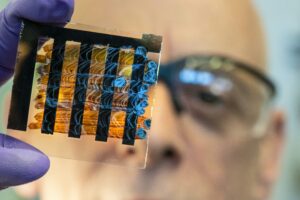
BUFFALO, NY — October 17, 2025 — A groundbreaking study published in the latest issue of Aging-US has unveiled a novel role for the Runx1 gene in the aging process of intervertebral discs. Researchers from Emory University School of Medicine and the Atlanta VA Medical Center have discovered that overexpression of Runx1 in spinal disc cells can lead to early onset of degeneration, offering new insights into the genetic factors contributing to chronic back pain.
The study, led by first author Takanori Fukunaga and corresponding author Hicham Drissi, highlights the potential for genetic intervention in treating age-related disc degeneration. The findings suggest that controlling Runx1 activity could pave the way for new therapeutic strategies aimed at mitigating back pain, a common affliction among aging populations.
Understanding Intervertebral Disc Degeneration
Intervertebral discs play a crucial role in cushioning the spine and facilitating movement. At the core of these discs lies the nucleus pulposus (NP), a gel-like center rich in proteins such as collagen and aggrecan, essential for retaining water and maintaining structural integrity. As individuals age, the functionality of NP cells diminishes, leading to disc deterioration and associated back pain.
In this study, researchers utilized a genetically modified mouse model to investigate the impact of Runx1 overexpression specifically in NP cells. The results were striking: mice with activated Runx1 exhibited signs of disc degeneration by just five months of age, significantly earlier than typically observed.
Mechanisms of Degeneration
The study revealed that Runx1 overexpression led to a loss of healthy NP cells, an increase in abnormal cell types, and structural damage to the discs. Notably, levels of critical proteins like aggrecan and type II collagen were reduced, while type X collagen, indicative of unhealthy tissue changes, increased.
“To achieve NP-specific postnatal overexpression of Runx1, we crossed Krt19CreERT mice with Rosa26-Runx1 transgenic mice previously generated in our laboratory,” the researchers explained.
A key discovery was that Runx1 overactivity did not directly kill cells but rather induced premature cellular aging, or senescence. Senescent cells lose their ability to repair tissue, creating an environment conducive to accelerated degeneration. Markers of senescence were significantly elevated in the affected discs.
Potential for Future Treatments
The researchers also noted a dose-dependent response: the more Runx1 was activated, the more severe the degeneration. This finding suggests that targeting Runx1 could be a promising strategy to prevent or slow disc aging.
Dr. Hicham Drissi commented on the implications of the study, stating,
“By identifying Runx1 as a potential driver of early disc aging, we open new opportunities for intervention and treatment of degenerative spine conditions.”
Broader Implications
This research not only sheds light on the genetic and cellular processes underlying intervertebral disc degeneration but also highlights the broader implications for understanding age-related diseases. As the population continues to age, the demand for effective treatments for degenerative spine conditions is expected to rise.
According to the World Health Organization, lower back pain is a leading cause of disability worldwide, affecting millions of people and placing a significant burden on healthcare systems. The discovery of genetic factors like Runx1 offers hope for developing targeted therapies that could alleviate this burden.
Looking Ahead
The findings from this study pave the way for future research into the role of Runx1 in other age-related conditions. As scientists continue to unravel the complexities of genetic contributions to aging, the potential for innovative treatments becomes increasingly promising.
For those interested in the detailed findings, the full study can be accessed through the following DOI: https://doi.org/10.18632/aging.206316.
As the scientific community continues to explore the genetic underpinnings of aging, the insights gained from this research may soon translate into tangible benefits for individuals suffering from chronic back pain and other degenerative conditions.






